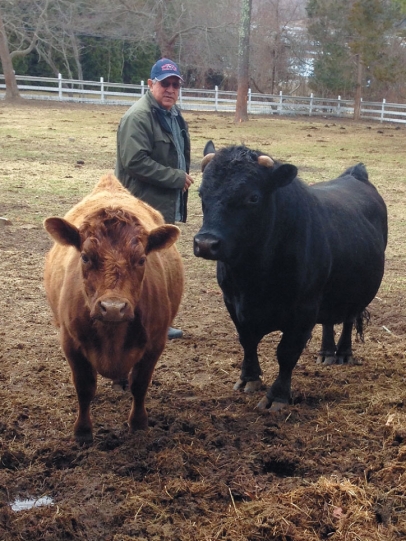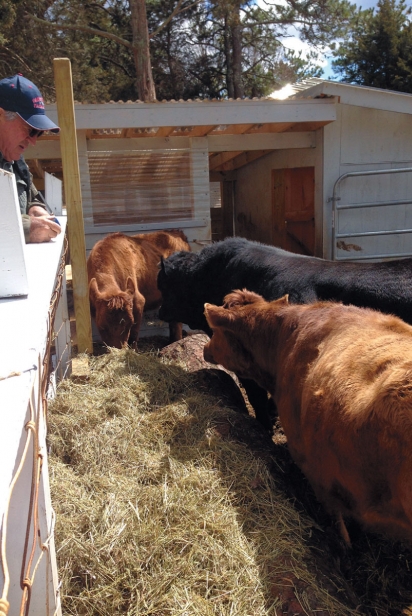The Family Cow
If you’ve ever toyed with the idea of owning your own family milk cow, but acreage was an issue, a miniature cow might be the perfect solution. Although seemingly a modern creation, mini cows actually date back through history for thousands of years. Many cattle breeds tended to be much smaller in stature before they came to America, when during the 1940s and ‘50s demand for beef was growing and the rolling grass plains of the west could support more and larger animals. In the early days of the American cattle industry, huge operations such as the King Ranch of Texas had thousands of acres to graze upon, unlike the peasant farmers of pastoral Europe who were allotted five acres or less, and not unlike many new, small farmers today who are faced with shrinking open lands and urban sprawl.
Miniature cows are the perfect solution for the small homesteader today. Minis range in size at three years of age from 36 inches in height to a maximum of 48 inches. This is one-half to one-third the size of normal cattle.
One mini milking cow can provide a gallon of fresh milk a day, and if butchering is an option, one or two minis provide enough meat for a small family for a year, with more choice cuts than an average-sized steer. With skyrocketing grain and hay prices, mini cows are also 25%- 30% more feed-efficient than large cattle. Just five acres can support a small herd of miniature cattle (ten miniatures, compared to only two average size). Being of such small stature also means that they are much easier to handle and that no “special” fencing and equipment are needed to raise them.
One popular and very interesting small breed of cattle is the Zebu, a miniature stature Brahman. (Brahmans are those majestic beauties you see at the rodeos and bull riding competitions with the large hump on their shoulders, and are very similar to the sacred cows that freely walk the streets of India). The Zebu originated as naturally small, primitive cattle and may date back as far as 6000 B.C. Miniature Zebu differ from most other mini cattle in that they are a “natural” breed. They are believed to have originated in Southern India or Sri Lanka.
Unlike other mini cow breeds, the Zebu was used to “breed up”, not down, to create their 2000- pound cousins, the American Brahmans. The first Zebu were brought to this country from India. Considered sacred, they could not be exported for consumption, but the British government, during its reign in that region, ignored the local customs and presented a few of these cattle as a gift to the United States government in 1854. During the next 50 years, the English allowed more cattle to be exported. The Brahman became the first developed American cattle breed. When you look at a Miniature Zebu, you are looking at a natural breed. When you look at a Brahman, you are looking at a giant Miniature Zebu.
In contrast to the naturally small Zebus being bred up, other breeds have been intentionally “bred down” to attain their small stature, Dexters being perhaps the most famous. Mature cows weigh 600–700 pounds and mature bulls weighs around 1000 pounds. Dexters make excellent milk cows, producing two to two-and-a-half gallons per day, but they are also excellent meat producers. Dexters are renowned for their friendly and playful personalities, and make great pets.
Their transformation began centuries ago in their Irish homeland and they were not intentionally meant to fall into the criteria of “mini” but rather a small, manageable, highly productive milk and meat cow. In the 1800s Irish breeders began developing a type of cattle known for its hardy nature and small size, and the breed became known as Irish Dexter. The preferred body type was very stocky and short legged, and this is where a problem within many miniature cow breeds began. Unintentionally, before the use of genetic testing, the selections they made to attain this short, stocky “type” were actually genetic dwarfs. This led to an array of problems within the breed. Some calves were born with a fatal defect known as “Bulldog” due to their compacted appearance, and many died at birth. Dwarfism can also be caused by environmental conditions such as when a cow is exposed to toxins, infection, poor body condition, or very extreme weather conditions during pregnancy. Once this indiscriminate selecting was recognized, the Dexter Breed Association began very diligently correcting the problem. Today the gene responsible for dwarfism has been identified and genetic testing is available at a minimal cost for Dexters before a buyer makes an investment.
Many of the miniature cattle breeds have been made by crossing Dexters with other breeds over the past few decades, and some of these breeds have also been affected, but here, too, there have been great strides made in monitoring the problem. Since 1980, in North America, most owners are working to produce a size and look similar to the original Dexter selection criteria, but without using the lethal mutation.
So it is now possible to be sure you are choosing good, genetically sound stock before purchasing an animal, and that is exactly what Joaquin Cesar did when he began his East Sandwich-based mini cow herd at Wingscorton Farm. Joe grew up in the agricultural southeast region of Brazil, São Paulo, where handling cattle was second nature to him. “They have a type of cattle there called a Zebu that they cross with Angus, producing magnificent offspring,” Joe said.
Joe came to the U.S. when he was 17 years old. He worked as a Boston detective for many years before moving to East Sandwich with his family, opening the Barnstable Farm & Pet feed store and starting his farm. Joe chose Dexter Jersey crosses called “Irish Jersey”, as his foundation stock. His stocky, black bull Chico, is a handsome fellow resembling something of a Black Angus. Bela and Linda are pretty little red Dexter looka- likes.
“The perfect family cows,” Joe explaines. “You get just the right amount of milk for a small family, no waste and easy to maintain, and an animal as friendly as a dog.” He tells me how milking is easy if done like his family always did. “Breed the cow once a year, but instead of taking the calf away from the mother (as they do in commercial operations) you leave the calf to grow healthy and strong while milking what you need. The cow will increase milk output, the calf will be content and grow strong, and this way you don’t even have to milk every day.”
What a novel idea! I guess that’s how they always did it on the “old country” family farm. Joe continues, “You still have to care for them 365 days a year, but even with this unusually cold and snowy winter they weren’t much trouble and came through it healthy with good body weight.”
Joe plans to raise just a couple calves each year, and will eventually be able to offer a few for sale.
There is now available quite a wide selection of miniature breeds and their crosses: the Belted Galloway, an extremely hardy breed with a great temperament; the Jersey, which can produce two to three gallons of high butterfat milk a day; the Hereford, which consumes about half that of full-sized cows and produces 50-75% of the meat; the Lowline Angus, not considered a miniature but rather just small-framed, a 100% dwarffree animal; the Texas Longhorn, bred-down from standard-sized Longhorns to approximately a third the size, very hardy in dry climates and good lean beef producers; the Scottish Highland, said to be similar to the size of the original cattle found on the Scottish Isles, an ancient breed used for beef and dairy and also as oxen; Holsteins, miniature milk cows that can produce two to three gallons of milk per day; and the Miniature Panda, a very rare mini, with a white belt and face with black ovals around the eyes, giving it a pandalike appearance. A panda calf can reputedly bring as much as $30,000. In general the average mini cow will cost between $800 and $2500.
The first cow in America arrived in Jamestown colony in 1611, and until the 1850s, nearly every family had its own cow. Modern life and disappearing open lands have compromised our food self-sufficiency. But the colloquial “family cow” no longer has to be a memory of days gone by. The mini cow is here and could definitely be the answer to rounding out our local, sustainable food table.






